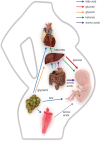Maternal cardiac metabolism in pregnancy
- PMID: 24448314
- PMCID: PMC3941596
- DOI: 10.1093/cvr/cvu009
Maternal cardiac metabolism in pregnancy
Abstract
Pregnancy causes dramatic physiological changes in the expectant mother. The placenta, mostly foetal in origin, invades maternal uterine tissue early in pregnancy and unleashes a barrage of hormones and other factors. This foetal 'invasion' profoundly reprogrammes maternal physiology, affecting nearly every organ, including the heart and its metabolism. We briefly review here maternal systemic metabolic changes during pregnancy and cardiac metabolism in general. We then discuss changes in cardiac haemodynamic during pregnancy and review what is known about maternal cardiac metabolism during pregnancy. Lastly, we discuss cardiac diseases during pregnancy, including peripartum cardiomyopathy, and the potential contribution of aberrant cardiac metabolism to disease aetiology.
Keywords: Heart; Metabolism; Peripartum cardiomyopathy; Pregnancy.
Figures



References
-
- King JC. Physiology of pregnancy and nutrient metabolism. Am J Clin Nutr. 2000;71(suppl.):1218S–1225S. - PubMed
-
- King JC. Maternal obesity, metabolism, and pregnancy outcomes. Annu Rev Nutr. 2006;26:271–291. - PubMed
-
- Di Cianni G, Miccoli R, Volpe L, Lencioni C, del Prato S. Intermediate metabolism in normal pregnancy and in gestational diabetes. Diabetes Metab Res Rev. 2003;19:259–270. - PubMed
-
- Lain KY, Catalano PM. Metabolic changes in pregnancy. Clin Obstet Gynecol. 2007;50:938–948. - PubMed
-
- Hytten FE, Leitch I. The Physiology of Human Pregnancy. Oxford: Blackwell Scientific Publications Ltd; 1971.
Publication types
MeSH terms
Grants and funding
LinkOut - more resources
Full Text Sources
Other Literature Sources
Medical

